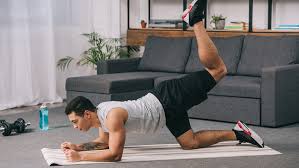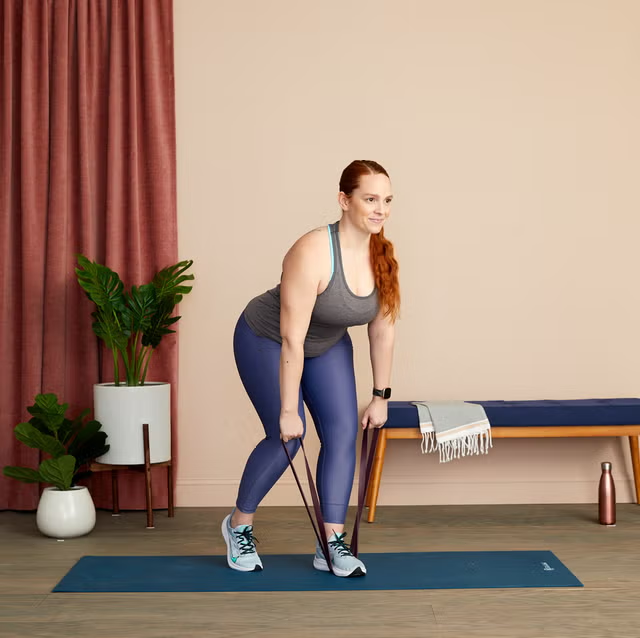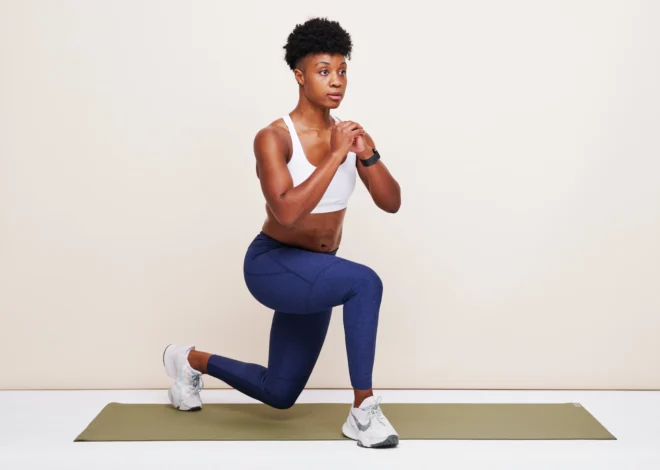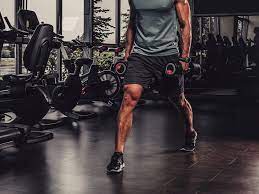
7 High-Impact Home Leg Workouts for Quick Results
1. Introduction: Why Home Leg Workouts Are Effective
Home Leg workouts play a crucial role in overall fitness and well-being. Our leg muscles are among the largest muscle groups in the body, and by strengthening them, we boost our metabolism, improve posture, and enhance endurance. Strong legs support our daily activities, from walking and running to lifting and balance. Moreover, toned legs enhance physical appearance and improve athletic performance and functional strength, which is essential for injury prevention and joint health. A regular leg workout routine is a cornerstone of a balanced fitness program.
Home leg workouts offer unmatched convenience. With a tiny space and a few exercises, you can perform a high-quality leg workout without needing a gym membership or equipment. Working out at home eliminates travel time and allows you to exercise whenever your schedule permits, making it easier to stay consistent. Home workouts also provide a stress-free, private environment to focus on form and technique. With various bodyweight and resistance-based exercises, home leg workouts can effectively build strength, endurance, and tone muscles, delivering gym-quality results with little or no equipment.
### 2. Benefits of High-Impact Home Leg Workouts
2. Benefits of High-Impact Home Leg Workouts
High-impact exercises, like jump squats and lunges, involve explosive movements that elevate the heart rate and challenge the muscles, leading to increased calorie burn and improved muscle tone. These exercises help build strength by engaging fast-twitch muscle fibers responsible for consequential, short bursts of movement. High-impact leg exercises also enhance endurance by pushing the cardiovascular system, allowing you to build stamina over time. Additionally, they improve coordination, agility, and stability, which benefits everyday activities and sports.
One of the significant benefits of high-impact home leg workouts is time efficiency. You can get a full leg workout in as little as 20–30 minutes, combining both strength and cardio elements for maximum effectiveness. Many high-impact exercises don’t require equipment, which allows you to integrate them seamlessly into your routine. You can easily fit these workouts into your day without a long commute to the gym or extended setup time, making it easier to commit to a consistent workout schedule and reach your fitness goals.
3. Equipment-Free Home Leg Workouts
Bodyweight Squats
Bodyweight squats are a fundamental exercise in any leg workout routine. They work multiple muscles in the lower body, including the quadriceps, hamstrings, glutes, and calves. Squats are highly effective for toning and strengthening the legs, as they recruit large muscle groups, which boosts metabolism and burns calories. Additionally, squats improve flexibility in the hips and ankles, contributing to better posture and reduced risk of injury. Bodyweight squats can be easily modified to increase intensity or target specific muscles, making them versatile and accessible.
Step-by-step guide to proper squat form:
– Start Position: Stand with feet shoulder-width apart, toes slightly turned out.
– Lowering Phase: Bend your knees and push your hips back as if sitting in a chair, keeping your chest up and back straight.
– Depth: Lower down until your thighs are parallel to the ground, or go as low as is comfortable without compromising form.
– Return to Start: Press through your heels to return to the standing position, squeezing your glutes at the top.
– Tips for Form: Keep your weight on your heels, avoid letting your knees cave inward, and maintain a neutral spine throughout the movement.
Lunges for Home Leg Strengthening
Lunges are another excellent bodyweight exercise for strengthening the legs, especially the quadriceps, hamstrings, and glutes. Lunges can be performed in various directions—forward, backward, and sideways—to target different muscles and improve balance and stability. Forward lunges focus on the front leg muscles, while backward lunges place more emphasis on the glutes. Side lunges, or lateral lunges, activate the inner thighs and outer glutes, improving hip mobility and helping to prevent injuries by working muscles that are often neglected.
Benefits for legs and glutes:
Lunges are a functional movement, meaning they mimic real-life actions, which helps improve everyday mobility and strength. They also engage the core, as balance is required to stabilize the body throughout the movement. Regularly incorporating lunges into your routine enhances leg muscle tone and definition while promoting unilateral strength (working each leg independently), which addresses muscle imbalances and increases overall leg stability.

Resistance-Based Home Leg Workouts
Resistance-based exercises add extra intensity to your home leg workouts, helping build muscle strength, increase endurance, and boost toning. Using resistance bands or dumbbells at home effectively challenges your leg muscles without needing large, heavy equipment.
Resistance Band Leg Press
Resistance bands provide variable resistance, which increases the tension as you stretch the band, challenging your muscles at different movement points. Bands are portable, affordable, and versatile, making them an ideal tool for home workouts. They help build strength, particularly in the quadriceps, hamstrings, and glutes, and improve muscle tone and endurance. They also reduce the impact on joints, which benefits beginners or those with joint concerns.
– Setup: Lie on your back with your knees bent and feet placed on the band. Hold the ends of the band in each hand to create tension.
– Positioning: Extend your legs against the band, creating resistance as you press.
– Movement: Slowly bend your knees, bringing them back toward your chest, then press your feet forward again, extending the legs against the band.
– Tips for Form: Keep your back pressed against the floor and control the movement in both directions. Avoid locking your knees when fully extended to reduce joint strain.
– Reps and Sets: Aim for 12-15 reps per set and complete 2-3 sets.

Single-Leg Deadlift with Dumbbells
The single-leg deadlift is a compound exercise that engages the hamstrings, glutes, and lower back. You enhance balance, stability, and coordination by performing the movement on one leg. This exercise builds muscle and improves unilateral strength, addressing muscle imbalances. The single-leg deadlift is highly effective for building the posterior chain (backside muscles), leading to better posture and reduced risk of injury.
Technique tips for balance and muscle engagement:
– Setup: Stand on one leg, holding a dumbbell in each hand with your arms extended.
– Movement: Keeping a slight bend in the standing knee, hinge at the hips, lowering the dumbbells toward the floor as your non-supporting leg extends back.
– Depth: Lower until you feel a stretch in your hamstring, then return to the start position by squeezing the glutes and pushing through the standing leg.
– Balance Tips: Focus on a spot before you to help with balance, and engage your core to keep your upper body stable.
– Reps and Sets: Start with 10-12 reps per leg and aim for 2-3 sets.
5. Cardio-Intensive Home Leg Workouts
Cardio-intensive exercises target leg muscles while providing cardiovascular benefits, making them ideal for calorie burning and endurance building. These exercises efficiently ton and strengthen the legs, enhancing heart and lung health.
Jump Squats for a High-Impact Cardio Boost
Jump squats are an explosive movement that increases heart rate, improving cardiovascular fitness and leg muscle endurance. This plyometric exercise works the quads, hamstrings, glutes, and calves, building strength and enhancing muscle tone. Jump squats also improve agility and coordination, making them an excellent addition to any home workout.
How to perform jump squats safely at home:
– Setup: Start with feet shoulder-width apart, toes slightly turned out.
– Lowering Phase: Perform a squat by bending your knees and pushing your hips back until your thighs parallel the ground.
– Explosive Jump: Push through your heels to jump up explosively, extending your legs and reaching upward with your arms.
– Landing: Land softly on the balls of your feet, bending your knees to absorb the impact, and immediately move into the next squat.
– Safety Tips: Keep your core engaged to protect your lower back, and avoid locking your knees on landing to reduce strain.
– Reps and Sets: Start with 10-15 jump squats per set and aim for 2-3 sets.

Step-Ups on a Sturdy Surface
Target muscles and benefits of step-ups:
Step-ups target the quadriceps, hamstrings, glutes, and calves while engaging the core for stability. They effectively build lower body strength and toning, particularly in the glutes. Step-ups mimic real-life movements like climbing stairs, making them a functional exercise that improves balance and coordination.
Proper form and recommended reps for quick results:
– Setup: Stand before a sturdy platform or step at knee height.
– Movement: Step one foot onto the platform, pressing through the heel to lift your body, then bring the other foot up to stand entirely on the platform.
– Lowering Phase: Step back down with one foot, then the other, to return to the start position.
– Tips for Form: Keep your chest upright and engage your core throughout the movement. Avoid leaning forward, and make sure the entire foot is on the platform to prevent slipping.
– Reps and Sets: Perform 12-15 reps per leg and aim for 2-3 sets.#### 6. Core-Strengthening Home Leg Workouts
Core-Strengthening Home Leg Workouts
Mountain Climbers for Leg and Core Activation
How mountain climbers work both the legs and core:
Mountain climbers are a dynamic, high-intensity exercise that works the lower body while engaging the core and shoulders. MountainMountain climbers require the core muscles to stabilize the body by starting in a plank position by starting in a plank position. As you alternate bringing each knee toward your chest, you activate the hip flexors, quads, hamstrings, and glutes. This movement mimics a running motion, which builds endurance and strength in the legs while keeping the core engaged.
Benefits of mountain climbers for home workouts:
Mountain climbers are ideal for home workouts because they don’t require any equipment and only take up a small amount of space. They provide a cardio boost, helping burn calories while strengthening the core and legs. Mountain climbers are versatile and can be done at various speeds to target either cardio or strength. They improve agility and coordination, making them great for overall fitness and functional strength.
Wall Sits for Leg Endurance
Wall sits are an isometric exercise that strengthens and tones the quads, hamstrings, and glutes by holding a seated position against a wall. Maintaining this position creates tension in the leg muscles without any movement, building muscular endurance and resilience. Wall sits are effective for building leg stability, helping with posture, and improving muscular stamina, which is beneficial for other leg exercises and daily activities.
Tips on increasing duration and intensity:
– Duration Increase: Start by holding the wall, sit for 20–30 seconds, and gradually increase the time as your endurance improves. Aim to add 5–10 seconds each week.
– Intensity Variations: Try holding a weight or medicine ball in your hands or placing it on your lap to add difficulty. Another way to increase intensity is to add single-leg holds, which lift one foot off the ground for a few seconds, alternating legs.
– Breathing Tips: Focus on deep, steady breaths to maintain stability and reduce muscle fatigue.
Sample Weekly Routine for Effective Home Leg Workouts
Here’s a sample weekly schedule combining strength, endurance, and cardio-focused leg exercises for a balanced and effective leg workout routine. Adjust as needed based on fitness level:
– Monday: Strength Training
– Bodyweight Squats – 3 sets of 15 reps
– Resistance Band Leg Press – 3 sets of 12 reps
– Wall Sits – 3 rounds of 30–45 seconds
– Tuesday: Cardio and Core Focus
– Jump Squats – 3 sets of 12 reps
– Mountain Climbers – 3 rounds of 30–45 seconds
– Step-Ups – 3 sets of 15 reps per leg
– Wednesday: Rest or light stretching to promote recovery
– Thursday: Endurance and Stability
– Lunges (alternating legs) – 3 sets of 12 reps per leg
– Single-Leg Deadlift with Dumbbells – 3 sets of 10 reps per leg
– Wall Sits – 3 rounds of 45–60 seconds
– Friday: Core Activation and Cardio
– Mountain Climbers – 3 rounds of 45 seconds
– Jump Squats – 3 sets of 15 reps
– Bodyweight Squats – 3 sets of 20 reps
– Saturday: Low-Intensity Recovery
– Light stretching or yoga, focusing on the legs and core
– Sunday: Rest
Tips on balancing intensity, rest days, and stretching for muscle recovery:
– Intensity Balance: Alternate high-intensity and low-intensity days to avoid overworking the muscles. Ensure a mix of strength and endurance exercises for well-rounded results.
– Rest Days: Include rest days or active recovery (like stretching or yoga) to give your muscles time to repair and grow. Rest is essential for muscle recovery and prevents burnout.
– Stretching: Include a short stretching routine after each workout to maintain flexibility, reduce muscle tightness, and aid recovery. Focus on quads, hamstrings, and glutes.

Final Tips for Success with Home Leg Workouts
– Safety: Always start with a warm-up to prepare your muscles and joints, reducing the risk of injury. Use proper form to avoid strain on joints, especially the knees and lower back.
– Form Focus: Maintain control and alignment in every movement. Improper form can lead to injuries and reduce the effectiveness of the workout.
– Motivation: Set small, achievable goals to stay motivated, such as increasing reps or hold times. Track your progress weekly to see improvements and maintain a positive mindset.
How to track progress and increase intensity over time:
– Tracking Progress: Keep a workout journal or use a fitness app to log reps, sets, and hold times for each exercise. Note any changes in form, strength, or endurance.
– Increasing Intensity: As your strength and endurance improve, increase the challenge by adding more reps, holding positions longer, or using additional resistance (e.g., resistance bands or weights). Gradually increasing intensity will challenge your muscles, promoting continued progress toward your fitness goals.
FAQs
How often should I do home leg workouts for quick results?
Aim for 2–3 times a week with a mix of high-intensity and resistance exercises.
Do I need equipment for effective home leg workouts?
No, bodyweight exercises are practical. Resistance bands or dumbbells can add variety but aren’t necessary.
Can I lose weight with just leg workouts at home?
Yes, leg workouts can help burn calories and improve muscle tone, aiding in weight loss combined with a healthy diet.
How do I avoid knee pain during home leg workouts?
Focus on proper form, warm up beforehand, and avoid high-impact exercises if you feel pain.
How long should each leg workout session be?
Aim for 20–30 minutes per session to allow for a good mix of exercises and rest intervals.
Are home leg workouts effective for building muscle?
Yes, especially when using resistance like body weight or bands. Consistency is key for muscle growth.
Can I add cardio to my leg workouts at home?
Exercises like jumping, squats, and mountain climbing provide both leg toning and cardio benefits.
What should I do if I feel sore after a workout?
Allow your muscles to recover with rest and light stretching, or do a low-intensity workout.
How soon will I see results from home leg workouts?
Results vary, but with consistency, you may start seeing toning in 4–6 weeks.
Are there low-impact home leg workouts for beginners?
Start with exercises like wall sits, lunges, and bodyweight squats to build strength without strain.
For more details [visit here]
Video [visit here]









One thought on “7 High-Impact Home Leg Workouts for Quick Results”